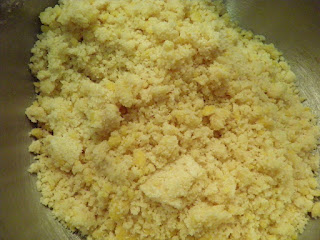The other day I made a half-batch of SK's delicious butter pie crust (which I have loved since I first made it for my Thanksgiving pies). It hung out in my fridge for about a week before I got around to baking into this. I followed-ish her recipe for a sweet cherry pie, but I subbed in mostly strawberries, didn't have almond extract, and used just some splashed of lemon juice from my squeeze bottle because I didn't have a fresh lemon on hand. But the great thing about dessert is that it really hates to go wrong, and I know I'm a pretty generous judge.
I didn't cook it long enough, I think, because the crust could have been flakier and more done through. Also I don't know if I used too much sugar or not enough corn starch, but I had a lot of liquid inside that I sort of poured off (but would be delicious if I was serving it with ice cream, so it isn't the worst problem). All said, I still thought it tasted delicious and sweet and summary, and I've already had almost half of it between last night and today.
Dough for a double-crust pie [I made a 1/2 recipe because I made a smaller pie]
4 cups pitted fresh cherries (about 2 1/2 pounds unpitted) [I used about a cup plus maybe two cups of strawberries]
4 tablespoons cornstarch [I used 2 tbsp]
2/3 to 3/4 cup sugar (adjust this according to the sweetness of your cherries) [I used 1/2 cup]
1/8 teaspoon salt
Juice of half a lemon
1/4 teaspoon almond extract [didn't have]
1 tablespoon cold unsalted butter, cut into small bits [I used 1/2 tbsp]
1 egg, beaten with 2 tablespoons water
Coarse sugar, for decoration
Preheat oven to 400°F.
Stir together the cherries, cornstarch, sugar, salt, lemon and almond extract gently together in a large bowl.
Roll out half of chilled dough (use larger piece, if you’ve divided them unevenly) on a floured work surface to 13-inch round. Gently place it in 9-inch pie pan, either by rolling it around the rolling pin and unrolling it over the pan or by folding it into quarters and unfolding it in the pan. Trim edges to a half-inch overhang.
Spoon filling into pie crust, discarding the majority of the liquid that has pooled in the bowl. Dot the filling with the bits of cold butter.
Roll out the remaining dough into a 12-inch round on a lightly floured surface, drape it over the filling, and trim it, leaving a 1-inch overhang. Fold the overhang under the bottom crust, pressing the edge to seal it, and crimp the edge decoratively. Brush the egg wash over over pie crust, then sprinkle with coarse sugar.
Cut slits in the crust with a sharp knife, forming steam vents, and bake the pie in the middle of the oven for 25 minutes. Reduce the temperature to 350°F. and bake the pie for 25 to 30 minutes more, or until the crust is golden. Let the pie cool on a rack. [Because mine was smaller, I watched it pretty carefully and it took about 35 minutes total.]
I didn't cook it long enough, I think, because the crust could have been flakier and more done through. Also I don't know if I used too much sugar or not enough corn starch, but I had a lot of liquid inside that I sort of poured off (but would be delicious if I was serving it with ice cream, so it isn't the worst problem). All said, I still thought it tasted delicious and sweet and summary, and I've already had almost half of it between last night and today.
Dough for a double-crust pie [I made a 1/2 recipe because I made a smaller pie]
4 cups pitted fresh cherries (about 2 1/2 pounds unpitted) [I used about a cup plus maybe two cups of strawberries]
4 tablespoons cornstarch [I used 2 tbsp]
2/3 to 3/4 cup sugar (adjust this according to the sweetness of your cherries) [I used 1/2 cup]
1/8 teaspoon salt
Juice of half a lemon
1/4 teaspoon almond extract [didn't have]
1 tablespoon cold unsalted butter, cut into small bits [I used 1/2 tbsp]
1 egg, beaten with 2 tablespoons water
Coarse sugar, for decoration
Preheat oven to 400°F.
Stir together the cherries, cornstarch, sugar, salt, lemon and almond extract gently together in a large bowl.
Roll out half of chilled dough (use larger piece, if you’ve divided them unevenly) on a floured work surface to 13-inch round. Gently place it in 9-inch pie pan, either by rolling it around the rolling pin and unrolling it over the pan or by folding it into quarters and unfolding it in the pan. Trim edges to a half-inch overhang.
Spoon filling into pie crust, discarding the majority of the liquid that has pooled in the bowl. Dot the filling with the bits of cold butter.
Roll out the remaining dough into a 12-inch round on a lightly floured surface, drape it over the filling, and trim it, leaving a 1-inch overhang. Fold the overhang under the bottom crust, pressing the edge to seal it, and crimp the edge decoratively. Brush the egg wash over over pie crust, then sprinkle with coarse sugar.
Cut slits in the crust with a sharp knife, forming steam vents, and bake the pie in the middle of the oven for 25 minutes. Reduce the temperature to 350°F. and bake the pie for 25 to 30 minutes more, or until the crust is golden. Let the pie cool on a rack. [Because mine was smaller, I watched it pretty carefully and it took about 35 minutes total.]





























